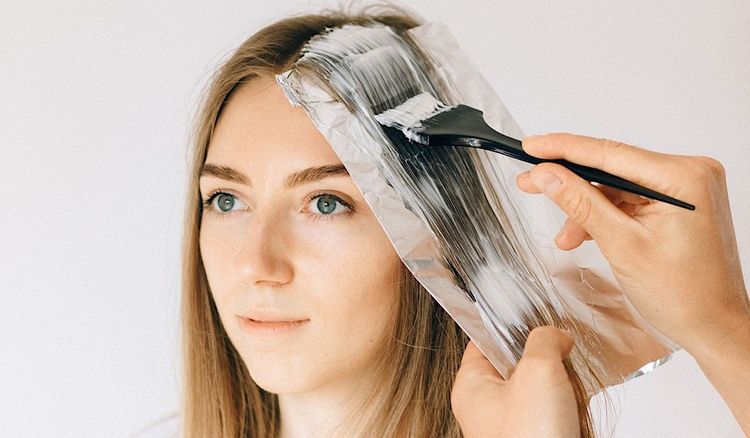How To Color White Hair Naturally At Home?

" Life isn't perfect but your hair can be. "
As we age, our hair may naturally turn white or gray, which can be a beautiful and distinguished look. However, some individuals may wish to add color to their white hair to enhance their overall appearance. While commercial hair dyes are available, they often contain harsh chemicals that can damage hair and irritate the scalp.
Let's explore together the various methods for coloring white hair naturally at home, including step-by-step instructions and helpful tips for achieving the best results.
So, whether you are looking to enhance your natural gray or white hair or add a touch of color, this guide is for you!
1. Henna.

For millennia, people have used plant-based dye and conditioner henna as a natural way to color and condition their hair. Depending on the natural color of the hair and how long the henna is left on the hair, the pigment lawsone in henna can give hair a reddish-brown hue.
When using henna, it is important to choose a high-quality powder that is free of additives or chemicals, which can be found at health food stores or online. To create a thick paste, mix the henna powder with warm water in a non-metallic bowl and let the mixture sit for several hours or overnight to release the dye.
A small tip to prevent the henna from staining your skin is to apply petroleum jelly or a thick cream around your hairline, ears, and neck. After sectioning your hair into manageable sections, apply the henna paste equally to your hair, working from the roots to the ends. To prevent stains on your palms, you may wear gloves. Once your hair is completely covered, pile it all on top of your scalp and wrap it in plastic wrap or a shower cap. Depending on how dark you want the color to be, leave the henna on your hair for several hours or overnight. The longer you leave it on, the darker the color will be.
2. Coffee.

Coffee is a popular natural remedy for those who want to darken their hair without using harsh chemicals since it contains natural pigments that can help temporarily darken hair.
To use coffee as a hair dye, brew a strong cup of coffee using 1/2 to 1 cup of coffee grounds per 2 cups of water and allow it to cool to room temperature. Pour the coffee over your hair and make sure to cover every inch of it, leaving it to rest for at least 30 to 60 minutes. Rinse the coffee out of your hair with warm water until the water runs clear. You may use a mild shampoo to remove any extra coffee residue, but avoid using conditioner for at least 24 hours after coloring your hair.
3. Sage And Rosemary.

Herbs such as sage and rosemary have been used for both health and aesthetic purposes for ages. They are a rich source of antioxidants, minerals, and natural pigments that can nourish and improve hair follicles, in addition to helping to darken hair.
To make a hair-darkening solution with sage and rosemary, put some powdered sage and rosemary in water and heat it until it boils. Allow it to simmer for about 30 minutes, stirring occasionally. After 30 minutes, remove the pot from the heat and allow the mixture to cool fully. Strain the mixture through a cheesecloth or fine-mesh sieve to remove any remaining plant matter.
Apply the mixture to your hair evenly after it has cooled, making sure to cover every inch of it. You can use a spray bottle, a brush, or your hands to apply the mixture and leave it on for at least an hour.
4. Black Tea.

Theaflavins, natural pigments, and polyphenols found in black tea can aid in naturally darkening hair. When applied to white hair, these pigments can temporarily stain the hair shaft and give it a darker, richer color. Black tea's tannins can also help to tighten the hair cuticles, resulting in smoother, shinier hair. This is especially beneficial for white or colorless hair, which is more prone to dryness and frizz.
To make a potent cup of black tea, use either loose tea leaves or tea sachets and allow the tea to cool down to room temperature before applying it to your hair. Depending on the desired color, other teas such as chamomile, rooibos, or hibiscus can be used.
5. Coconut Oil And Lemon Remedy.

The coconut oil and citrus remedy is commonly used to naturally lighten hair rather than as a hair dye. Lemon juice's natural acids can break down melanin in the hair, resulting in a lighter hair pigment. In addition, hair can benefit from the nourishing and conditioning properties of coconut oil, which can also protect against damage.
To use this remedy, mix 1 tablespoon of freshly squeezed lemon juice with 2 tablespoons of coconut oil. Apply the mixture evenly throughout your hair, ensuring that all strands are covered. Take some time to massage it into your hair and scalp.
6. Walnut Shells.

Uglone, a natural pigment found in walnut shells, can be used as a hair dye. To begin, boil the walnut shells in water for about an hour, then strain and allow the liquid to settle. Once cooled, apply the liquid to your hair, making sure to cover every strand, and leave it in for at least an hour. Rinse your hair thoroughly with cool water. Juglone in the walnut shell dye bonds with the proteins in the hair to create a natural and long-lasting color. It's important to note that the final color outcome can vary depending on the natural color and texture of your hair.
Embracing your natural white hair can be a liberating and empowering experience. However, if you wish to add some color to your locks, there are many natural and safe ways to do so from the comfort of your own home. By using ingredients like henna, black tea, coffee, or sage, you can enhance your hair's natural beauty without exposing it to harmful chemicals. Remember, the key to achieving a great result is patience and experimentation.
So, take your time, have fun, and enjoy the journey of discovering the perfect natural color for your white hair.
Happy reading!

